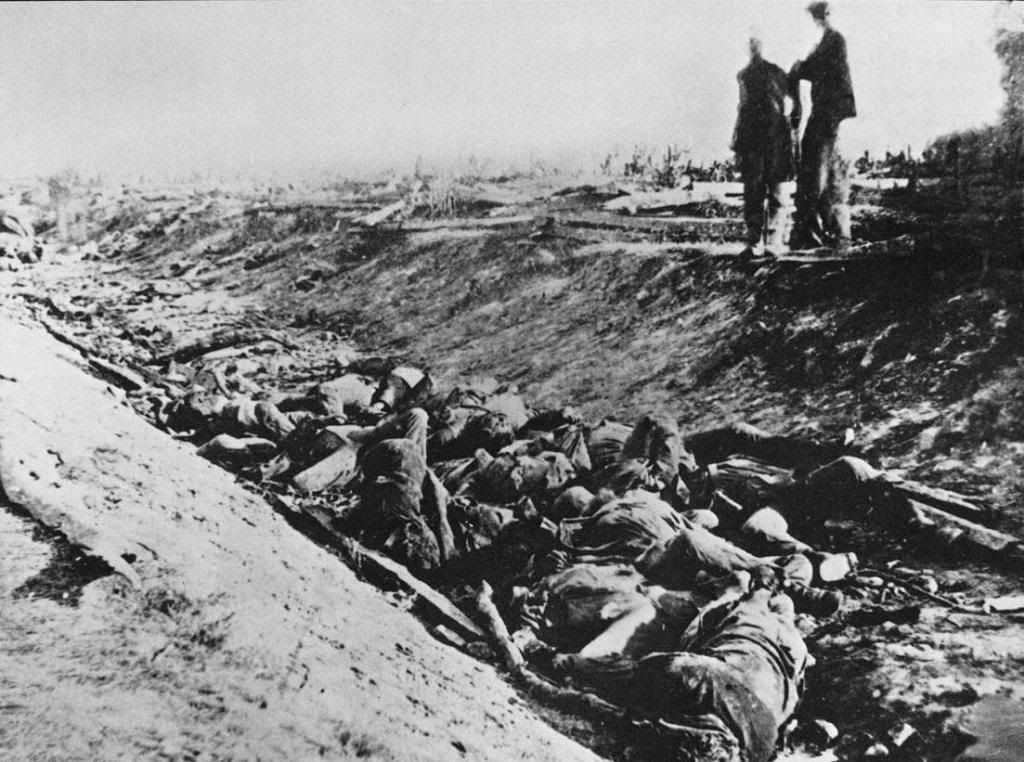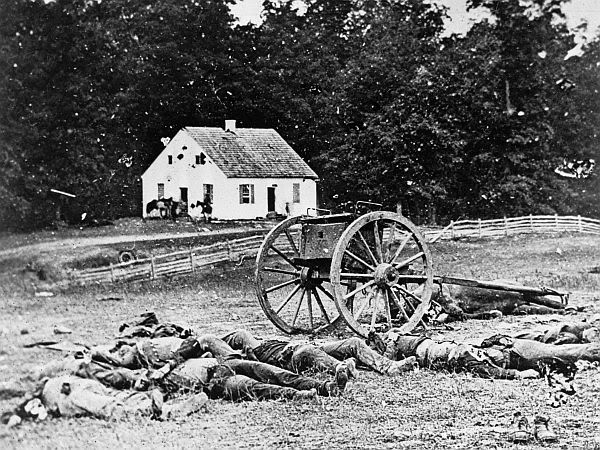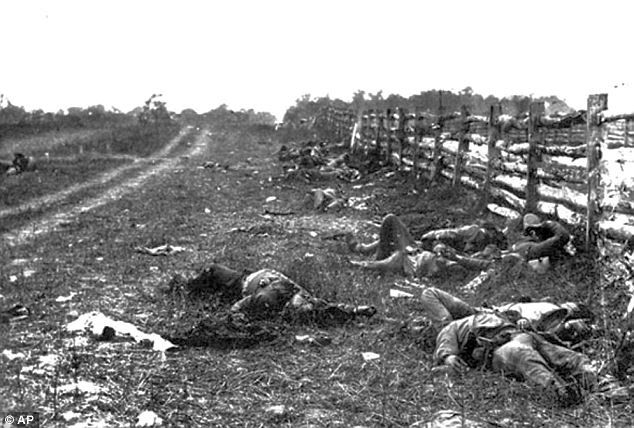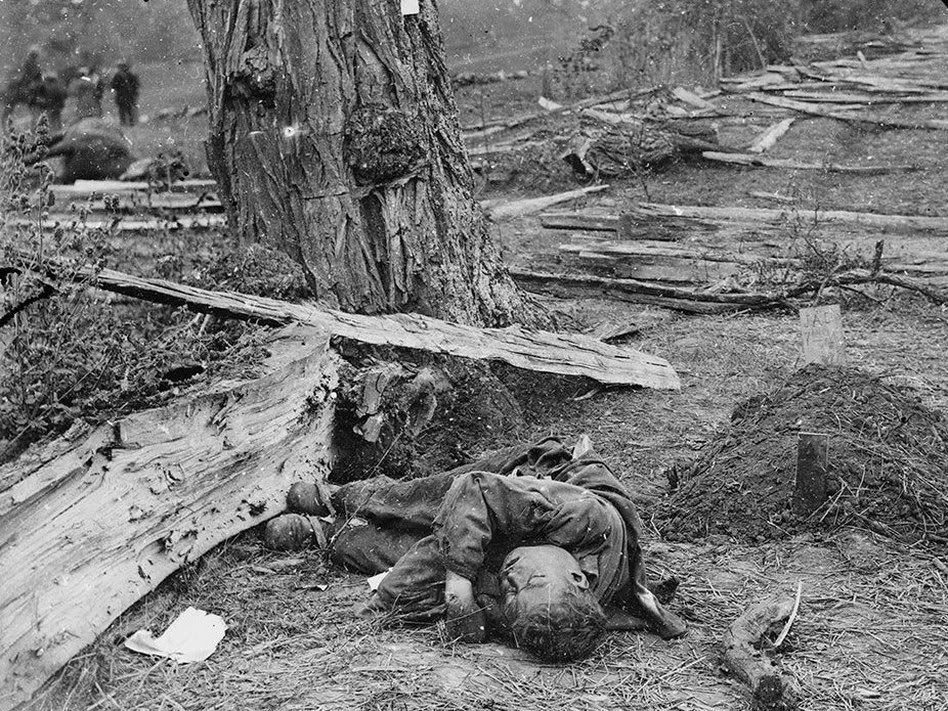 From Time LightBox:
From Time LightBox:
150 Years Later: Picturing the Bloody Battle of Antietam
Today marks the 150th anniversary of the single bloodiest conflict
ever witnessed on American soil. The Civil War’s Battle of Antietam,
fought 60 miles outside of Washington D.C., resulted in 23,000 Union and
Confederate casualties in just 12 hours—a statistical horror never
replicated again in any conflict fought within the United States.
The Battle of Antietam marked the first time the Union substantially
halted a string of Confederate advances into the North. Looking back,
historians conclude the victory allowed President Lincoln to issue the
Emancipation Proclamation—fundamentally altering the context of the
nation’s conflict, and thus, our understanding of the battle’s
importance.
Were a battle of this magnitude to erupt today, we would know about
it within seconds—breaking news alerts would buzz in our pockets,
anchors would interrupt our regularly scheduled programs and social
media would drill down on the latest details of the rapidly evolving
situation. Often, we intake news imagery before knowing all the details,
and in the early hours following the conflict, we might not know the
full meaning of what occurred, but we definitely know what it looked
like.
One hundred and fifty years ago, on the other hand, the public viewed
painfully explicit photographs with unconditioned eyes—the first time
America visually confronted the carnage of its conflict.
After the Battle of Antietam, photographer Mathew Brady tacked a sign
to the door of his New York City photo studio that read, simply, “The Dead of Antietam.”
Inside, he exhibited the work that his assistant, Alexander Gardner,
made in the aftermath of the inconceivably bloody fighting at Antietam
Creek. The show drew a large crowd.
One particular viewer, Oliver Wendell Holmes, took notice of Gardner’s photographs, and in an 1863 issue of the Atlantic Monthly,
penned his reaction. “It is not [for viewers] to bear witness to the
fidelity of views which the truthful sunbeam has delineated in all their
dread reality,” he writes. “The sight of these pictures is a commentary
on civilization such as the savage might well triumph to show its
missionaries.”
Holmes writes of the dreadful accuracy with which Gardner’s
photographs depict the gruesome casualties of war. Photography, less
than 50 years old in 1862, was still understood by many as an extension
of painting. Early critics were often split between a view of
photography as objectively accurate or grossly inaccurate and incapable
of matching the magnitude of the scenes it recorded (either for want of
detail or of a ‘correct’ perspective).
Holmes, it seems, falls in the latter camp. As an eyewitness to the
Battle of Antietam, he bristles at the idea that the public may, after
viewing Gardner’s work, presume to understand the true nature of war. He
mentions that the emotions came flooding back to him as a witness to
the scenes captured by Gardner—emotions that he would like to lock in
the recesses of a far-off place. Holmes feels that this pictorial
representation, while succeeding in capturing the physical setting of
war, does nothing to convey the visceral nature of conflict among men
that he witnessed. Yet he still acknowledges how the public is moved
practically to tears as they realize the implicit significance of
Gardner’s photos. Although they don’t understand what he feels as a
witness, they are moved in ways they shouldn’t be afforded as mere
casual viewers of recorded conflict.
The New York Times echoed Holmes’ chilly wonder at how
captivating Gardner’s war photographs seemed. The paper noted that the
public response to Gardner’s images was as if the photographer had
“brought bodies and laid them in our dooryards and along the streets.”

We have become inured to them and to things like them.
“You will see hushed, reverend groups standing around these weird
copies of carnage…chained by the strange spell that dwells in dead men’s
eyes,” they write.
Images of today’s conflicts still arrest us just as they did in 1862.
We pause, marveling at their vibrancy, viciousness and pictorial
excellence. The world of 2012 allows us to “like” them, “share” them,
and “re-tweet” them, hoping to pass along to others the feelings they
elicit in us.
Gardner’s pictures articulated a different utility. Depicting the
dead fathers and sons of a generation, his plates represent one of the
first times America was forced to confront its own
tragedy—emotionally—immediately after the fact.
While today we perceive and employ the Antietam photographs as memory
triggers and historical records, the public of 1862 confronted them with no expectations or precedent.
Unconditioned (and perhaps not yet protected by) the daily and hourly
cataract of imagery that we endure today, Civil War-era viewers
recognized Gardner’s images for what they were: immediate reminders of
the brutal nature of mankind. And thus, on the 150th anniversary of the
bloody conflict at Antietam, it’s worth pause to consider how the modern
image of conflict impacts us.


Featured Post
It seems Pope Francis needs to brush up on his Tertullian!
It has been reported (in The ChristLast Media, I must note) that the current Pope does not like the phrase "lead us not into temptation...
"Let no freedom be allowed to novelty, because it is not fitting that any addition should be made to antiquity. Let not the clear faith and belief of our forefathers be fouled by any muddy admixture." -- Pope Sixtus III
Monday, September 17, 2012
The bloodiest day in American history happened 150 years ago today...
Posted by
TheChurchMilitant
at
3:24 PM
![]()
Subscribe to:
Post Comments (Atom)
About Me
- TheChurchMilitant
- First of all, the word is SEX, not GENDER. If you are ever tempted to use the word GENDER, don't. The word is SEX! SEX! SEX! SEX! For example: "My sex is male." is correct. "My gender is male." means nothing. Look it up. What kind of sick neo-Puritan nonsense is this? Idiot left-fascists, get your blood-soaked paws off the English language. Hence I am choosing "male" under protest.
Labels
- "What difference at this point does it make?” (20)
- #HimToo (2)
- 24 (24)
- A little Latin lingo (16)
- AIDS (4)
- Animal Flesh Recipes (42)
- Are you a fake conservative? (146)
- ATTACK FROM THE RIGHT! (281)
- Battleground: Pennsylvania (25)
- Big Babykilling (152)
- Big Masturbation (53)
- Bolshevik The Clown (139)
- Book of the Day (122)
- Catholic Apologetics (25)
- Catholic crackup (74)
- Charlie Gard got the death penalty you know (10)
- Clump lies and freedom dies (111)
- Clump Rising (31)
- Clump über alles (53)
- Clump über alles. (47)
- Clumpy The Clown (70)
- Conservative Crackup (188)
- Dumbass Cinema (34)
- FUCK TRUMP IN THE RUMP (130)
- Germaine Greer In Drag (15)
- GET YOUR WOMBS OUT OF MY WALLET (58)
- GOVERNMENT IS HELL ON EARTH (77)
- GOVERNMENT IS MURDER (78)
- GOVERNMENT IS THEFT (172)
- Guilty Pleasures (80)
- Guns Don't Kill Abortionists Do (23)
- Heap Big Lying Squaw (5)
- Heat Nazis (71)
- In an insane society a sane man must appear to be insane (19)
- In vitro no one can hear you scream (54)
- It Takes A Village To Staff A Gestapo Unit (112)
- Jennifer Love Hewitt Love (11)
- LENIN OR GANDHI? (1)
- Lyin'-ass Bitch in the White House (138)
- Mayor McTerror (2)
- Mittens The Pompadoured Pussy (16)
- NeverClump (39)
- None Dare Call It Fascism (263)
- None Dare Call It Sin (70)
- None dare call it treason (274)
- Obama-rama (161)
- Orgasm Über Alles (114)
- Penis bad Vagina good (82)
- PLUTO HELD HOSTAGE (101)
- Power Is Love (65)
- Racist. (93)
- Real Mensches Of Genius (39)
- Reel Cinema (12)
- Religion of Peace and Love and Et Cetera (196)
- SEX IS DEATH (126)
- Shakespearean insults (15)
- She With The Unmentionable Straightened Hair (6)
- Sodomy: The New Black (54)
- Stop me if you've heard this one. (20)
- The face of things to come (4)
- The First Hair Straightener (22)
- The King Abdullah Gazette (306)
- The Long Hot Zombie Summer (36)
- The Theology of the Body (178)
- Third World problems (11)
- Totalitarian Pennsylvania (71)
- VOTE FOR ROMNEY NOT THE COMMIE (71)
- What Would Giffords Do? (35)
- Words don't kill People do (127)
- Zardoz (8)
FYODOR"S LINKS
- Major K. - He's home now, but his blog from Iraq remains.
- The Mudville Gazette
- BLACKFIVE
- Iraq The Model
- Catholic Encyclopedia
- 365 and a Wakeup - He's home now, but his blog from Iraq remains.
- Iowahawk
- theOneRepublic
- Captain's Quarters
- Michael Yon - old blog here
- A Star From Mosul
- Peeve Farm-Breeding peeves for show, not just to keep as pets.
- BlameBush! Because Bush is to Blame for Everything.
- CRISIS Magazine
- Disaffiliates-Think Twice
- Where have you gone, Ronald Reagan?
- (Get your own "Wars Prevented by the UN" counter here.)
- WI Catholic Musings
- Network of College Conservatives
- The Musings of David Amulet
- joannejacobs.com
- Stop The ACLU
- Crossed The Tiber
- R2K
- I link what I like. Show me what you've got.
Blog Archive
-
►
2018
(12)
- ► 03/04 - 03/11 (1)
- ► 01/14 - 01/21 (5)
- ► 01/07 - 01/14 (6)
-
►
2017
(500)
- ► 12/17 - 12/24 (1)
- ► 12/10 - 12/17 (5)
- ► 12/03 - 12/10 (2)
- ► 11/26 - 12/03 (4)
- ► 11/12 - 11/19 (5)
- ► 11/05 - 11/12 (1)
- ► 10/29 - 11/05 (19)
- ► 10/22 - 10/29 (4)
- ► 10/15 - 10/22 (6)
- ► 10/08 - 10/15 (2)
- ► 10/01 - 10/08 (6)
- ► 09/24 - 10/01 (3)
- ► 09/10 - 09/17 (7)
- ► 09/03 - 09/10 (6)
- ► 08/27 - 09/03 (12)
- ► 08/20 - 08/27 (17)
- ► 08/13 - 08/20 (10)
- ► 08/06 - 08/13 (7)
- ► 07/30 - 08/06 (11)
- ► 07/23 - 07/30 (14)
- ► 07/16 - 07/23 (13)
- ► 07/09 - 07/16 (26)
- ► 07/02 - 07/09 (15)
- ► 06/25 - 07/02 (14)
- ► 06/18 - 06/25 (9)
- ► 06/11 - 06/18 (14)
- ► 06/04 - 06/11 (15)
- ► 05/28 - 06/04 (12)
- ► 05/21 - 05/28 (16)
- ► 05/14 - 05/21 (20)
- ► 05/07 - 05/14 (19)
- ► 04/30 - 05/07 (18)
- ► 04/23 - 04/30 (17)
- ► 04/16 - 04/23 (9)
- ► 04/09 - 04/16 (5)
- ► 04/02 - 04/09 (17)
- ► 03/26 - 04/02 (23)
- ► 03/19 - 03/26 (14)
- ► 03/12 - 03/19 (13)
- ► 03/05 - 03/12 (13)
- ► 02/26 - 03/05 (17)
- ► 02/19 - 02/26 (11)
- ► 02/12 - 02/19 (13)
- ► 02/05 - 02/12 (9)
- ► 01/29 - 02/05 (4)
- ► 01/22 - 01/29 (1)
- ► 01/15 - 01/22 (1)
-
►
2016
(99)
- ► 12/25 - 01/01 (2)
- ► 12/18 - 12/25 (1)
- ► 12/11 - 12/18 (4)
- ► 12/04 - 12/11 (1)
- ► 11/27 - 12/04 (2)
- ► 11/20 - 11/27 (2)
- ► 11/13 - 11/20 (3)
- ► 11/06 - 11/13 (2)
- ► 10/23 - 10/30 (2)
- ► 10/16 - 10/23 (2)
- ► 10/09 - 10/16 (3)
- ► 09/18 - 09/25 (3)
- ► 08/07 - 08/14 (3)
- ► 07/31 - 08/07 (4)
- ► 07/24 - 07/31 (4)
- ► 07/17 - 07/24 (4)
- ► 07/10 - 07/17 (5)
- ► 07/03 - 07/10 (5)
- ► 06/19 - 06/26 (6)
- ► 06/12 - 06/19 (5)
- ► 06/05 - 06/12 (1)
- ► 05/29 - 06/05 (4)
- ► 05/22 - 05/29 (1)
- ► 05/15 - 05/22 (4)
- ► 05/08 - 05/15 (2)
- ► 05/01 - 05/08 (3)
- ► 04/24 - 05/01 (2)
- ► 04/17 - 04/24 (1)
- ► 04/10 - 04/17 (2)
- ► 03/27 - 04/03 (3)
- ► 03/13 - 03/20 (2)
- ► 03/06 - 03/13 (1)
- ► 02/21 - 02/28 (2)
- ► 01/24 - 01/31 (4)
- ► 01/17 - 01/24 (4)
-
►
2015
(18)
- ► 12/13 - 12/20 (1)
- ► 12/06 - 12/13 (1)
- ► 11/29 - 12/06 (3)
- ► 09/13 - 09/20 (1)
- ► 09/06 - 09/13 (1)
- ► 08/23 - 08/30 (2)
- ► 08/16 - 08/23 (2)
- ► 07/26 - 08/02 (1)
- ► 04/19 - 04/26 (1)
- ► 02/08 - 02/15 (2)
- ► 02/01 - 02/08 (3)
-
►
2014
(54)
- ► 11/02 - 11/09 (8)
- ► 09/21 - 09/28 (4)
- ► 09/14 - 09/21 (5)
- ► 08/03 - 08/10 (2)
- ► 07/27 - 08/03 (4)
- ► 07/20 - 07/27 (1)
- ► 06/29 - 07/06 (1)
- ► 06/22 - 06/29 (6)
- ► 06/15 - 06/22 (1)
- ► 06/08 - 06/15 (1)
- ► 06/01 - 06/08 (7)
- ► 05/18 - 05/25 (3)
- ► 05/11 - 05/18 (10)
- ► 05/04 - 05/11 (1)
-
►
2013
(11)
- ► 12/01 - 12/08 (1)
- ► 11/24 - 12/01 (1)
- ► 11/17 - 11/24 (8)
- ► 02/24 - 03/03 (1)
-
▼
2012
(665)
- ► 12/09 - 12/16 (5)
- ► 12/02 - 12/09 (6)
- ► 11/25 - 12/02 (1)
- ► 11/11 - 11/18 (2)
- ► 11/04 - 11/11 (1)
- ► 10/28 - 11/04 (16)
- ► 10/21 - 10/28 (15)
- ► 10/14 - 10/21 (23)
- ► 10/07 - 10/14 (8)
- ► 09/30 - 10/07 (19)
- ► 09/23 - 09/30 (13)
-
▼
09/16 - 09/23
(40)
- Watch as reality is is twisted before your very eyes!
- I get mail...
- SEX IS DEATH. (Technologically facilitated crazy l...
- What? You mean 'Paris Hilton' ISN'T a 'gay' guy?
- America's first illegal alien president blames the...
- Death is racist.
- WHEW!!!!! It's almost time to see if the last four...
- Dumbo The Presiphant's* perverse life of crime, ig...
- Dumbo The Presiphant's* perverse life of crime, ig...
- Dumbo The Presiphant's* perverse life of crime, ig...
- Dumbo The Presiphant's* perverse life of crime, ig...
- Dumbo The Presiphant's* perverse life of crime, ig...
- Dumbo The Presiphant's* perverse life of crime, ig...
- Dumbo The Presiphant's* perverse life of crime, ig...
- Dumbo The Presiphant's* perverse life of crime, ig...
- Dumbo The Presiphant's* perverse life of crime, ig...
- Dumbo The Presiphant's* perverse life of crime, ig...
- Dumbo The Presiphant's* perverse life of crime, ig...
- Dumbo The Presiphant's* perverse life of crime, ig...
- Dumbo The Presiphant's* perverse life of crime, ig...
- "Your child's too stupid to understand 'Huckleberr...
- From The Death Of The West Department:
- Yeah, like that jug-eared ghoul is Mr. Rogers...
- Here's yet another one The Onion wishes it had wri...
- I see the inane drones at LiveScience.com have had...
- What do they do when they find out MLK Jr. loved P...
- Google grows a temporary spine, but just wait unti...
- Stop me if you've heard this one...
- For the third time in this campaign, Mittens stumb...
- Fellatio D. Rascalvelt continues to steal our mone...
- Can one be "authentically black" AND Christian?
- The execrable mass-murdering pervert Jeffrey MacDo...
- Father-son dances are the new normal.
- Jen, in case you need a place to stay...
- The Party of Blasphemy, Buggery, and 'Bortion sees...
- Not to worry, Doc, chronic masturbation is taking ...
- The dead squirrels at the ACLU get one right.
- Only in Obamastan.
- ...and 1 year ago, Sodomize Wall Street started.
- The bloodiest day in American history happened 150...
- ► 09/09 - 09/16 (7)
- ► 09/02 - 09/09 (17)
- ► 08/26 - 09/02 (18)
- ► 08/19 - 08/26 (23)
- ► 08/12 - 08/19 (37)
- ► 08/05 - 08/12 (13)
- ► 07/29 - 08/05 (15)
- ► 07/22 - 07/29 (25)
- ► 07/15 - 07/22 (24)
- ► 07/08 - 07/15 (18)
- ► 07/01 - 07/08 (18)
- ► 06/24 - 07/01 (25)
- ► 06/17 - 06/24 (4)
- ► 06/10 - 06/17 (27)
- ► 06/03 - 06/10 (12)
- ► 05/27 - 06/03 (30)
- ► 05/20 - 05/27 (24)
- ► 05/13 - 05/20 (12)
- ► 05/06 - 05/13 (14)
- ► 04/29 - 05/06 (2)
- ► 04/22 - 04/29 (5)
- ► 04/15 - 04/22 (6)
- ► 04/08 - 04/15 (7)
- ► 04/01 - 04/08 (2)
- ► 03/25 - 04/01 (16)
- ► 03/18 - 03/25 (6)
- ► 03/11 - 03/18 (12)
- ► 03/04 - 03/11 (15)
- ► 02/26 - 03/04 (11)
- ► 02/19 - 02/26 (12)
- ► 02/12 - 02/19 (19)
- ► 02/05 - 02/12 (11)
- ► 01/29 - 02/05 (2)
- ► 01/22 - 01/29 (8)
- ► 01/15 - 01/22 (5)
- ► 01/08 - 01/15 (2)
- ► 01/01 - 01/08 (12)
-
►
2011
(692)
- ► 12/25 - 01/01 (3)
- ► 12/18 - 12/25 (8)
- ► 12/04 - 12/11 (9)
- ► 11/27 - 12/04 (8)
- ► 11/06 - 11/13 (8)
- ► 10/30 - 11/06 (11)
- ► 10/23 - 10/30 (7)
- ► 10/16 - 10/23 (14)
- ► 10/09 - 10/16 (13)
- ► 10/02 - 10/09 (4)
- ► 09/25 - 10/02 (15)
- ► 09/18 - 09/25 (5)
- ► 09/11 - 09/18 (20)
- ► 09/04 - 09/11 (11)
- ► 08/28 - 09/04 (27)
- ► 08/21 - 08/28 (25)
- ► 08/14 - 08/21 (18)
- ► 08/07 - 08/14 (29)
- ► 07/31 - 08/07 (37)
- ► 07/24 - 07/31 (21)
- ► 07/17 - 07/24 (30)
- ► 07/10 - 07/17 (28)
- ► 07/03 - 07/10 (12)
- ► 06/26 - 07/03 (14)
- ► 06/19 - 06/26 (9)
- ► 06/12 - 06/19 (5)
- ► 06/05 - 06/12 (14)
- ► 05/29 - 06/05 (7)
- ► 05/22 - 05/29 (8)
- ► 05/15 - 05/22 (31)
- ► 05/08 - 05/15 (19)
- ► 05/01 - 05/08 (12)
- ► 04/24 - 05/01 (9)
- ► 04/17 - 04/24 (15)
- ► 04/10 - 04/17 (15)
- ► 04/03 - 04/10 (10)
- ► 03/27 - 04/03 (18)
- ► 03/20 - 03/27 (13)
- ► 03/13 - 03/20 (16)
- ► 03/06 - 03/13 (21)
- ► 02/27 - 03/06 (27)
- ► 02/20 - 02/27 (14)
- ► 02/13 - 02/20 (2)
- ► 02/06 - 02/13 (8)
- ► 01/30 - 02/06 (8)
- ► 01/23 - 01/30 (11)
- ► 01/16 - 01/23 (11)
- ► 01/09 - 01/16 (6)
- ► 01/02 - 01/09 (6)
-
►
2010
(42)
- ► 12/26 - 01/02 (2)
- ► 12/19 - 12/26 (1)
- ► 11/21 - 11/28 (1)
- ► 11/14 - 11/21 (3)
- ► 11/07 - 11/14 (1)
- ► 09/05 - 09/12 (1)
- ► 08/29 - 09/05 (15)
- ► 08/22 - 08/29 (4)
- ► 08/15 - 08/22 (4)
- ► 08/08 - 08/15 (5)
- ► 07/25 - 08/01 (1)
- ► 05/16 - 05/23 (3)
- ► 03/07 - 03/14 (1)
-
►
2007
(849)
- ► 11/11 - 11/18 (10)
- ► 11/04 - 11/11 (61)
- ► 10/28 - 11/04 (38)
- ► 10/21 - 10/28 (66)
- ► 10/14 - 10/21 (59)
- ► 10/07 - 10/14 (48)
- ► 09/30 - 10/07 (76)
- ► 09/23 - 09/30 (40)
- ► 02/11 - 02/18 (27)
- ► 02/04 - 02/11 (74)
- ► 01/28 - 02/04 (85)
- ► 01/21 - 01/28 (104)
- ► 01/14 - 01/21 (96)
- ► 01/07 - 01/14 (65)
-
►
2006
(3989)
- ► 12/31 - 01/07 (63)
- ► 12/24 - 12/31 (57)
- ► 12/17 - 12/24 (77)
- ► 12/10 - 12/17 (88)
- ► 12/03 - 12/10 (79)
- ► 11/26 - 12/03 (73)
- ► 11/19 - 11/26 (35)
- ► 11/12 - 11/19 (71)
- ► 11/05 - 11/12 (112)
- ► 10/29 - 11/05 (86)
- ► 10/22 - 10/29 (60)
- ► 10/15 - 10/22 (102)
- ► 10/08 - 10/15 (72)
- ► 10/01 - 10/08 (76)
- ► 09/24 - 10/01 (71)
- ► 09/17 - 09/24 (86)
- ► 09/10 - 09/17 (81)
- ► 09/03 - 09/10 (62)
- ► 08/27 - 09/03 (84)
- ► 08/20 - 08/27 (75)
- ► 08/13 - 08/20 (90)
- ► 08/06 - 08/13 (69)
- ► 07/30 - 08/06 (95)
- ► 07/23 - 07/30 (89)
- ► 07/16 - 07/23 (23)
- ► 07/09 - 07/16 (78)
- ► 07/02 - 07/09 (57)
- ► 06/25 - 07/02 (111)
- ► 06/18 - 06/25 (103)
- ► 06/11 - 06/18 (85)
- ► 06/04 - 06/11 (73)
- ► 05/28 - 06/04 (68)
- ► 05/21 - 05/28 (90)
- ► 05/14 - 05/21 (73)
- ► 05/07 - 05/14 (84)
- ► 04/30 - 05/07 (74)
- ► 04/23 - 04/30 (65)
- ► 04/16 - 04/23 (77)
- ► 04/09 - 04/16 (65)
- ► 04/02 - 04/09 (84)
- ► 03/26 - 04/02 (86)
- ► 03/19 - 03/26 (87)
- ► 03/12 - 03/19 (65)
- ► 03/05 - 03/12 (69)
- ► 02/26 - 03/05 (53)
- ► 02/19 - 02/26 (75)
- ► 02/12 - 02/19 (52)
- ► 02/05 - 02/12 (90)
- ► 01/29 - 02/05 (97)
- ► 01/22 - 01/29 (89)
- ► 01/15 - 01/22 (66)
- ► 01/08 - 01/15 (51)
- ► 01/01 - 01/08 (46)
-
►
2005
(2291)
- ► 12/25 - 01/01 (41)
- ► 12/18 - 12/25 (49)
- ► 12/11 - 12/18 (64)
- ► 12/04 - 12/11 (72)
- ► 11/27 - 12/04 (56)
- ► 11/20 - 11/27 (55)
- ► 11/13 - 11/20 (25)
- ► 11/06 - 11/13 (75)
- ► 10/30 - 11/06 (86)
- ► 10/23 - 10/30 (68)
- ► 10/16 - 10/23 (69)
- ► 10/09 - 10/16 (61)
- ► 10/02 - 10/09 (62)
- ► 09/25 - 10/02 (65)
- ► 09/18 - 09/25 (79)
- ► 09/11 - 09/18 (82)
- ► 09/04 - 09/11 (64)
- ► 08/28 - 09/04 (81)
- ► 08/21 - 08/28 (86)
- ► 08/14 - 08/21 (64)
- ► 08/07 - 08/14 (85)
- ► 07/31 - 08/07 (61)
- ► 07/24 - 07/31 (60)
- ► 07/17 - 07/24 (58)
- ► 07/10 - 07/17 (75)
- ► 07/03 - 07/10 (82)
- ► 06/26 - 07/03 (79)
- ► 06/19 - 06/26 (94)
- ► 06/12 - 06/19 (104)
- ► 06/05 - 06/12 (75)
- ► 05/22 - 05/29 (49)
- ► 05/15 - 05/22 (52)
- ► 05/08 - 05/15 (38)
- ► 05/01 - 05/08 (65)
- ► 04/24 - 05/01 (8)
- ► 04/17 - 04/24 (2)
No comments:
Post a Comment